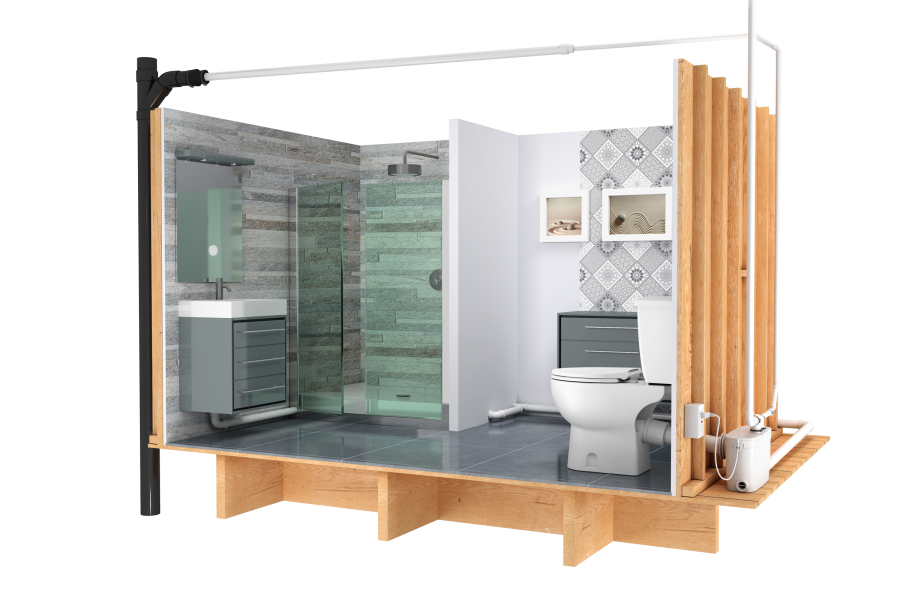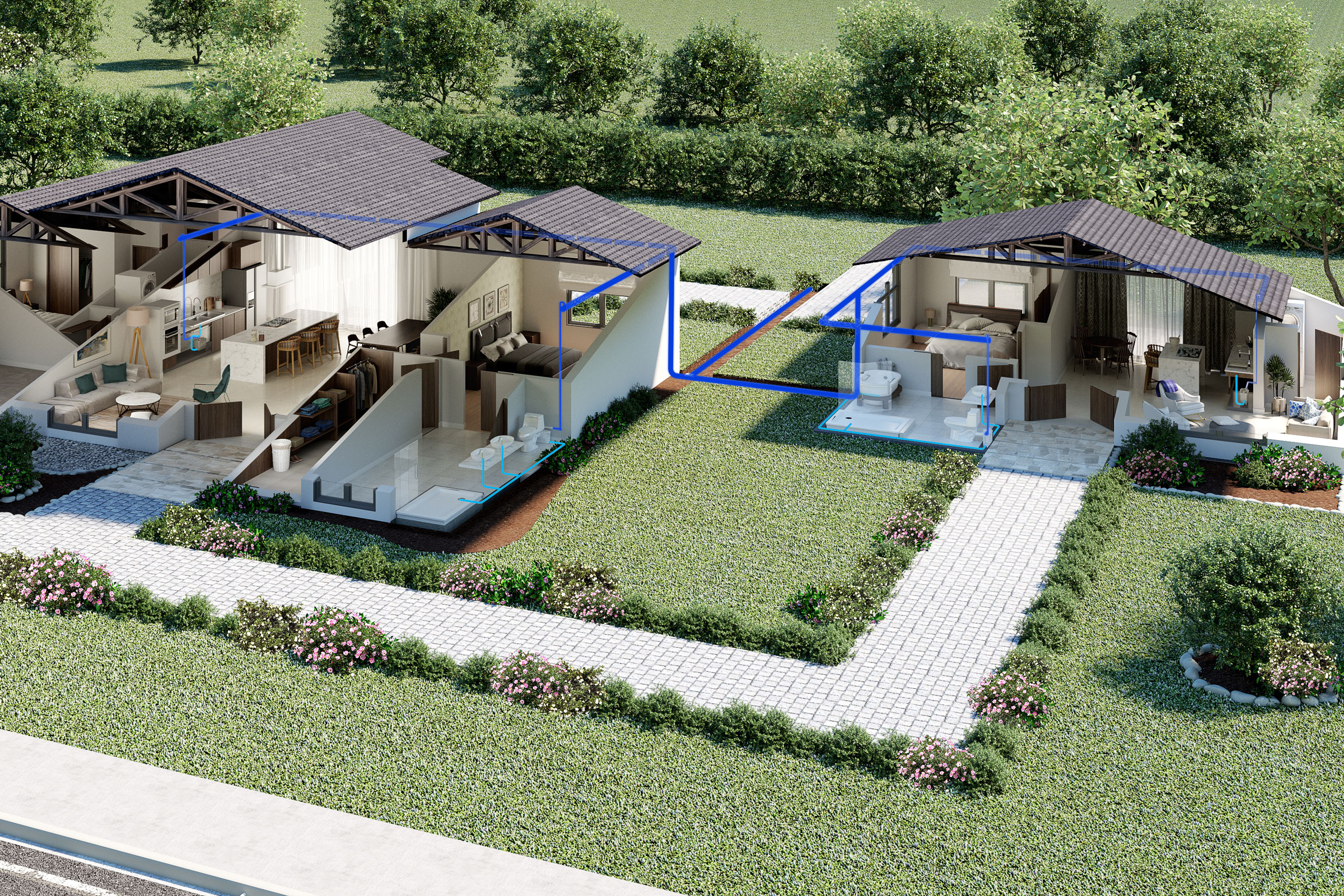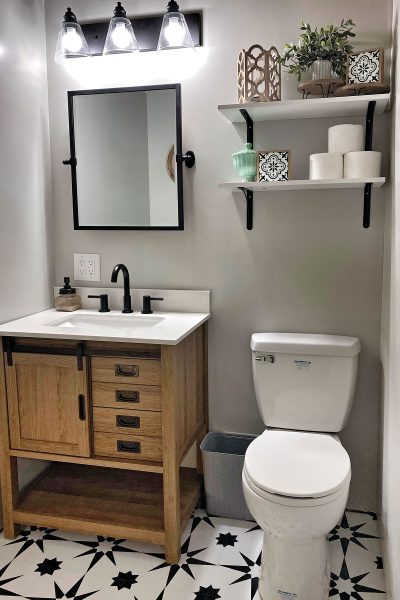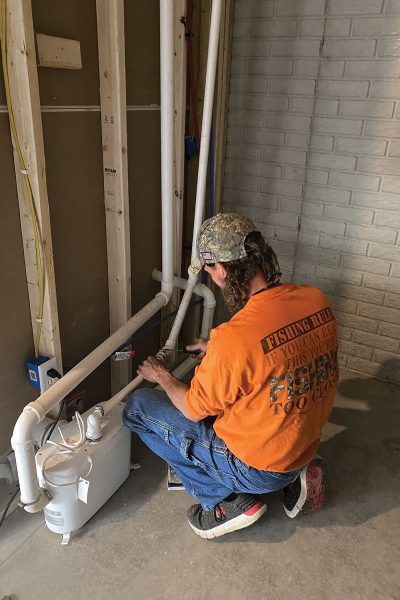Story at a glance:
- Above-ground plumbing is gaining traction as an efficient and cost-effective alternative for many applications.
- The process uses smaller diameter pipes—one-inch diameter or less, versus four-inch diameter found in traditional plumbing.
- The technology eliminates the need to break floors or walls and trench out to sewer lines and offers flexibility for design within the space.
It may come as no surprise that a significant amount of existing building stock wasn’t designed with today’s needs in mind. A space’s adaptability is often a factor when deciding to renovate versus starting over from scratch. Accommodating the addition or retrofit to traditional plumbing systems can be a costly challenge and a major coordination headache. This is what many homeowners discovered as they looked to upgrade or add bathrooms—particularly in parts of the country with older building stock and basements, like in the Northeast.
This geographic area is also where Saniflo SFA, a French manufacturer of pumps and plumbing equipment, launched its North American operations in the 1990s (SFA was established in Europe in 1958). Their macerating pump technology became a great fit for homeowners looking to add living space to basements, including bathrooms. Today the company markets macerating technology through 29 subsidiaries doing business in more than 70 countries worldwide.
“Breaking concrete, trying to trench throughout the whole basement for four-inch diameter pipes that need gravity, sometimes it wasn’t even possible because you didn’t know what you’d find,” says Jose Pachas, a technical manager for Saniflo in the US.
Saniflo’s above-ground plumbing solution is comprised of a macerating pump paired with a back outlet toilet versus a bottom outlet toilet. “Macerating systems use a grinding mechanism to turn waste into slurry for easy drainage,” Pachas says.
The pump grinds the water and waste into a fine slurry within three to four seconds and is then pumped out through either three-quarter-inch or one-inch pipe. The pump and the pipes together allow for discharge up to 150 feet across, with a vertical discharge range up to 25 feet, eliminating the need for gravity and all the other impacts accommodating larger diameter pipes.
The pump motors come in 0.5 and one horsepower versions to support a range of use, from residential to commercial or even modular and recreational vehicles. Saniflo’s above-ground plumbing systems also come with a four-year warranty.
The Benefits

Image courtesy of Saniflo and Greenhouse Digital + PR Agency
Above-ground flooring can positively impact a project’s environmental footprint in a multitude of ways. Saniflo’s toilets qualify for the WaterSense label, helping aid in water conservation and reducing strain on existing plumbing infrastructure.
But perhaps its greatest benefit is its versatility. There’s no need to break through existing floors or concrete (and rebuild them) nor trench out to public sewer systems or to septic tanks. The small diameter pipe means it can be easily hidden in a corner or along the ceiling.
Above-ground plumbing can be used for upper-level additions or renovations, and the macerating pump technology can accommodate other bathroom needs, too. “The system has inlets to connect the shower and the sink, so a complete bathroom drains into it,” Pachas says. “Our pump will grind everything up and pump it out on demand.”
Robert Grunnah, owner of Austin House Buyer Now, says he often looks to above-ground plumbing technology to add bathrooms that help properties sell—especially in small or unusual spaces. He says it can be ideal for adding other plumbing amenities like laundry rooms, outdoor kitchens (the pumps can be paired with greywater fixtures), attic wet bars, or lofted office suites, and he recently used it when he converted an old carriage house into a guest suite. “Conventional plumbing would have needed demolishing the old flooring—a difficult and expensive process,” Grunnah says.
A Historic Task

The pump and the pipes together allow for discharge up to 150 feet across, with a vertical discharge range up to 25 feet, eliminating the need for gravity and all the other impacts accommodating larger diameter pipes. Image courtesy of Saniflo and Greenhouse Digital + PR Agency
As awareness of the benefits of above-ground plumbing grows, so do opportunities for broader applications. With commercial office vacancy levels continuing to average nearly 20% nationwide, even approaching 30% in some areas, many cities and developers are looking for cost-efficient ways to redevelop these office properties into multifamily. A new product, the Sanifos fully packaged pump station range, is coming soon, too.
Conversions are not without their challenges—among them adapting floor plates that have just a few large restrooms with multiple toilets and sinks to become individual full bathrooms in each private unit. Pachas says Saniflo offers small lift stations that can accommodate multiple bathrooms using the same pump technology.
Conventional plumbing would have needed demolishing the old flooring—a difficult and expensive process.
One such project in Wilkinsburg, Pennsylvania, currently in design, is looking to above-ground plumbing as part of the solution. The Wilkinsburg Community Development Corporation hopes to convert a former 15,000-square-foot bank from 1908 into residential use to bring 12 to 16 new homes to market. Greg Marin, principal at Pittsburgh-based JuCi Arc architecture firm, says above-ground plumbing may help the team overcome some of the design challenges. “The distribution of multiple bathrooms across a floor plan presents an array of challenges, especially in a historic building,” he says.
A terra-cotta floor, decorative plaster ceiling, and accessibility are more challenges the project poses. “Saniflo’s technology allows us to transport waste from any location with only a one-inch pipe so all of these problems are solved at once,” Marin says.
He says he and his team are consulting with Saniflo to work through technical issues related to upgrading historic properties. “Designers need to account for acoustics, power outage, potential malfunction, and local plumbing codes,” he says.
Broad Application
- Photo courtesy of Saniflo and Greenhouse Digital + PR Agency
- Photo courtesy of Saniflo and Greenhouse Digital + PR Agency
Pachas points to opportunities in commercial projects, too, like when Saniflo helped the Target Corporation add numerous Starbucks coffee retail operations in its existing stores. “They needed an easy and inexpensive concept—and without disrupting business,” Pachas says.
Saniflo’s technology complies with IPC, UPC, and NSPC plumbing codes, ensuring code compliance in nearly all US states. Its products are tested and certified by CSA Group and listed with IAPMO—both internationally recognized organizations for standards, testing, inspection, and certification. Saniflo is also an active member of ASPE and collaborated with ASME in developing the macerating pump standard, Pachas says.
He says the many years of sharing technology, code, and work with engineers centers around helping the world understand that above-ground plumbing is an efficient and cost-effective solution to the needs of the built environment. “Just because you’ve been breaking the concrete for the past 50 years, that doesn’t mean that’s the only way you could achieve what you need to do.”



